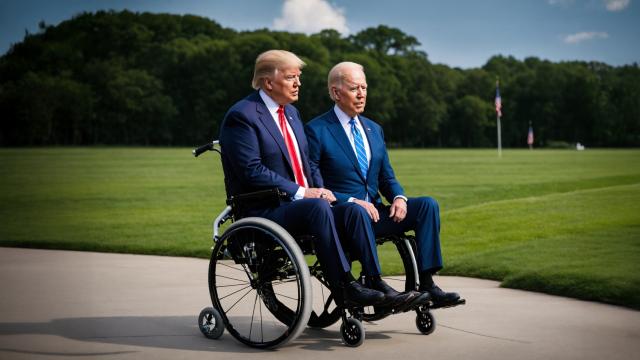
There’s a huge missing piece in the ongoing national conversation over former President Joe Biden’s doomed bid for a second term.
The new book “Original Sin” by journalists Jake Tapper and Alex Thompson explores how Biden’s inner circle effectively hid the octogenarian 46th president’s declining health from voters and even from other White House staff until it was too late. Biden’s disastrous performance in a June 2024 debate against then-candidate Donald Trump ultimately assured Trump’s victory, with Vice President Kamala Harris only having a little more than 100 days to run a 50-state campaign whereas Trump had been campaigning almost constantly for nine years.
We’ll never know if Biden dropping out of the race earlier and giving Democrats the chance to run a nationwide primary and nominate a worthy opponent for Trump would have changed the result of the election, in which a mood of anti-incumbency had captured the electorate both in the United States and abroad. But there is one topic worth discussing in response to the national debate that Tapper and Thompson kick-started with their book that goes beyond the narrow focus of Biden’s 2024 campaign.
Gerontocracy endangers democracy
Both Biden, and Democrats at large, have been widely criticized for clinging to power too long, and denying the younger generation the chance to lead. One key example is former House Speaker Nancy Pelosi (D-California) announcing in 2022 that she and the other remaining leaders of the House Democratic Caucus would be handing off power to younger Democrats, only to use her influence behind the scenes to push Democrats to back septuagenarian Rep. Gerry Connolly (D-Virginia) as ranking member of the House Oversight Committee over the much younger and more charismatic Rep. Alexandria Ocasio-Cortez (D-New York). Connolly narrowly defeated Ocasio-Cortez in the final vote, only to succumb to cancer just months later.
Had Pelosi not gotten involved, it’s entirely possible that the highest-ranking Democrat on one of the most vital House committees tasked with holding the Trump administration accountable would have been a 35 year-old, media-savvy progressive with millions of committed followers. And in the event Democrats win back control of the House after the 2026 midterms, Ocasio-Cortez would have been on TV every day as Oversight chair, holding regular hearings educating the public on the worst excesses of the Trump regime.
The 119th Congress has been rife with examples of aging Democrats dying in office, with Reps. Raul Grijalva (D-Arizona) and Sylvester Turner (D-Texas) also passing away at the ages of 77 and 70, respectively, after having just run for reelection in the fall of 2024. And last year, Reps. Sheila Jackson Lee (D-Texas), Donald Payne (D-New Jersey) and Bill Pascrell (D-New Jersey) died at the ages of 74, 65, and 87, respectively.
It could be argued that the House of Representatives’ recent passage of Trump’s so-called “One Big Beautiful Bill Act” — which cuts Medicare, Medicaid, and food stamps by hundreds of billions of dollars to fund a massive new tax cut overwhelmingly geared toward the richest Americans – by a slim 215-214 margin was made possible by aging Democrats who stayed in office too long dying before being able to vote against it.
Likewise, in the U.S. Senate, gerontocracy – or rule by the elderly — has also hindered Democrats’ ability to effectively counter the worst impulses of Senate Republicans. Sen. Dianne Feinstein (D-California), who died in office in September of 2023 at the age of 90, stepped down from her role on the critically important Judiciary Committee due to a shingles infection. This left Democrats with a 10-10 tie with Republicans on the committee, and even some of Feinstein’s colleagues in the party questioned whether she should remain in office. Sen. Amy Klobuchar (D-Minnesota) called Feinstein’s absence from the Judiciary Committee “an issue for the country.”
While it’s important to honor the deceased lawmakers’ commitments to public service, it’s also worth having a conversation about selfishly clinging to power to the detriment of the country at large. This conversation also played out when the late Justice Ruth Bader Ginsburg died in September of 2020 only to be replaced by Justice Amy Coney Barrett — who is decidedly against many of the policies Ginsburg championed.
Ginsburg could have retired in 2013, when President Barack Obama had just been reelected to a second term and Democrats controlled the Senate, and when she was already 80 years old. Ginsburg had also been diagnosed with pancreatic cancer in 2009, and while she underwent surgery to have the cancer removed, that was ultimately what took her life just months before the 2020 election. Had she retired in 2013 and been replaced with an Obama appointee, the 5-4 Dobbs v. Jackson Women’s Health decision that overturned Roe v. Wade and jeopardized abortion rights across the country may have been prevented entirely.
Clinging to power at the expense of the future
Biden was elected at the age of 78, but he had effectively run on being a one-term president. In fact, one unnamed “prominent adviser” to his 2020 campaign told Politico in 2019 that in order to assuage younger voters in the party’s more left-leaning faction, Biden would “choose a running mate and a Cabinet that is young and diverse,” and cast himself as “the candidate best suited to defeat Trump as well as the candidate who can usher into power the party’s fresh faces.”
“If Biden is elected,” the adviser said, “he’s going to be 82 years old in four years and he won’t be running for reelection.”
“This makes Biden a good transition figure,” the adviser continued. “I’d love to have an election this year for the next generation of leaders, but if we have to wait four years [in order to] get rid of Trump, I’m willing to do it.”
While Biden didn’t publicly make a pledge to just serve one term, Politico reported that this was due to him not wanting to lose political capital and enter the White House as a lame duck. However, Biden made repeated promises on the campaign trail that alluded to him aiming to hold power for just four years. The Atlantic reported that during a 2020 rally in Detroit, Michigan alongside Harris and Democratic Governor Gretchen Whitmer, whom he called “the future of this country,” Biden said: “Look, I view myself as a bridge, not as anything else.” He would later say: “I view myself as a transition candidate.”
After he won the 2020 election, Biden largely followed through on this, with Kamala Harris — the first Black woman to be elected US senator from California — serving as vice president. Biden also made efforts to select an incredibly diverse Cabinet that looked like America. This included the first LGBTQ+ Cabinet secretary, the first Black secretary of defense, and a record-high number of women (12) serving as Cabinet secretaries, including eight women of color.
But Biden broke that supposed promise to not seek another term after Republicans’ promised “red wave” in the 2022 midterms failed to materialize. The GOP just barely regained control of the House of Representatives while Democrats made gains in the Senate, going from a 50-50 tie with Harris as a frequent tie-breaker to an outright 51-49 majority. The Washington Post reported last year that some Democrats viewed that as a sign that Biden should once again be the party’s standard-bearer in 2024.
“My intention is that I run again,” Biden said on the day after the midterms. And while he said at the time he would leave that decision up to “fate,” author Chris Whipple told the Post that Biden looked at a second term as an inevitability.
“He’d spent his whole life trying to get there,” Whipple said. “He was certainly not going to walk away from the opportunity to fulfill the work he’d started in his first term. And I think that’s just the nature of people who reach that job.”
In retrospect, the best decision Biden could have made to “fulfill the work” of his first term — which this author maintains was a decidedly progressive four years in terms of policies enacted — was to declare victory over Trump and the Covid-19 pandemic and ride off into the sunset, saying that it was up to the next generation to carry the torch. This could have given Democrats the opportunity to simultaneously shake off the albatross of incumbency that Harris was unable to remove from her neck in 2024, and run a full 50-state primary in which the best candidate with the best ideas emerged after a lengthy competition.
The Democrats could have used that primary to show off their deep bench of political talent, including governors, Cabinet secretaries, and members of the House and Senate, of varying ages and backgrounds, all with unique experience, against the old and tired ideas of Donald Trump that voters already rejected in 2020. While it’s too late to change the past, the Democrats have a chance to try this approach in 2028 — if they’re bold enough.
How the Democratic Party could take a stand against gerontocracy
Initially, Rep. Jan Schakowsky (D-Illinois), who just turned 81 years old on May 26, had no plans to abandon her seat in Congress. However, when 26 year-old progressive activist Kat Abughazaleh declared her candidacy in Shakowsky’s district and out-raised her in the first quarter of 2025, the octogenarian congresswoman announced she was retiring after 14 terms in the House of Representatives.
Abughazaleh may not win next year’s primary, as she does not yet officially live in the district and is facing multiple primary opponents that include longtime Illinois state legislators from the area. But her mere entry into the race resulted in an entrenched incumbent reading the writing on the wall and stepping aside to make room for the next generation of leaders.
This is the thinking behind what progressive activist David Hogg — who was elected vice chair of the Democratic National Committee (DNC) — has called for ahead of the 2026 midterm elections. Hogg’s group, Leaders We Deserve, has set aside $20 million in an effort to seek challengers to longtime Democratic incumbents in deep-blue districts that have no chance of flipping to GOP control in order to rid the party of older, fossilized Democrats that have so far refused to pass the baton to the next generation.
The Marjory Stoneman Douglas High School shooting survivor argued that the Democratic Party’s dismal approval rating (which Pew found was lower than that of Republicans) necessitated a “dramatic shift” toward newer leaders and newer ways of thinking. He emphasized that his effort is focused on the House of Representatives, where elections are decided by much smaller margins than at the statewide level.
“The first most important thing here is to understand it isn't necessarily just out with the old and in with the new. I would say it's out with the ineffective and in with the effective," the 25 year-old Hogg told ABC News in April. "Any person that has eyes can see that we are 27% approval with our base and we need dramatic change."
In a May interview with the Guardian, Hogg defended his effort to oust “asleep at the wheel” House Democrats who were upholding “an indefensible status quo that has caused voters in almost every demographic group to move away from us.”
“We need to dramatically change,” Hogg said. “The fact that we spent $2 billion last election cycle and still lost to a convicted felon who attempted to overthrow our government – and despite the fact that he has crashed our economy, despite the fact that he has disappeared people – our approvals remain where they are is a serious indictment of our party.”
Hogg’s position has excited younger Democrats but put him at odds with party leadership, with DNC chair Ken Martin reiterating that the national party will remain neutral in primaries. And Hogg will have to fight for his job as DNC vice chair between June 9 and June 11, with losing vice chair candidate Kalyn Free arguing that Hogg and Malcolm Kenyatta (another DNC vice chair) were improperly elected due to a tabulation error. Hogg maintains that the vote that could potentially oust him is due to his threats to entrenched Democratic incumbents.
Already, younger Democrats are demonstrating leadership, and at least one of the oldest members of Congress is showing what it looks like to pass the torch. Sen. Bernie Sanders (I-Vermont), who caucuses with Democrats, has been holding rallies with Rep. Ocasio-Cortez across the country as part of their “Fight Oligarchy” tour. The two progressive lawmakers have been drawing massive crowds even in staunchly Republican areas, as they did in Missoula, Montana in April. Ocasio-Cortez told the capacity crowd in Missoula that Republicans are hoping to divide the working class against itself as a means of keeping ordinary Americans “distracted” from the effort to plunder their future.
“They know it hurts you, but they are not there to serve working families in Montana. They are there to serve themselves and the billionaires who pay them,” she said. “But they know that the only chance that they have to get away with such a deeply unpopular agenda is to try to stoke deep divisions along race, identity and culture to keep us fighting and distracted.”
The Bronx congresswoman also used her speech to clearly articulate the values Democrats should run on. She argued that community-building among people of all political backgrounds was necessary for “establishing a living wage, to tackle skyrocketing rents and mortgages, to take on the climate crisis and establish a country where the American dream is actually possible for all of us.”
Already, the “Fight Oligarchy” tour is producing dividends for Ocasio-Cortez’s brand of politics. A plurality of Americans polled in May (26%) said that the 35 year-old progressive lawmaker was the new “face” of the Democratic Party. While another 26% of respondents said there was no face of the party at this point in time, Sanders was the next most-favored option by respondents, with 12% choosing him. Rep. Jasmine Crockett (D-Texas) came in third with 8% calling her the face of the party. But AOC left all other options in the dust, including Kamala Harris (6%) and former Transportation Secretary Pete Buttigieg (5%).
What 2025 has already shown is that the conventional Democratic Party thinking of responding to public opinion – as California Governor Gavin Newsom has done by taking a conservative position on transgender people — is far less effective than shaping public opinion with bold policy positions and vociferously defending those positions at every opportunity.
Democrats can shake off old ways of thinking by standing on their visions for the future even in conservative areas, threatening longtime incumbents in safe blue districts with primary challenges, and passing the baton to the next generation to ensure the work of creating a better society for everyone can continue. On the other hand, the old generation clinging to their power and to old, outdated ideas can have dire consequences, as the 2024 election demonstrated. Which path will Democrats choose?
Carl Gibson is a journalist whose work has been published in CNN, USA TODAY, the Guardian, the Washington Post, the Houston Chronicle, the Louisville Courier-Journal, Barron’s, Business Insider, the Independent, and NPR, among others. Follow him on Bluesky @crgibs.bsky.social.


















